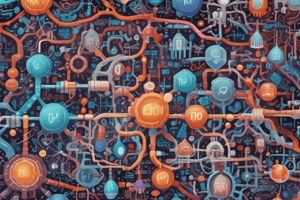Podcast
Questions and Answers
What is the primary function of amino acid metabolism in the human body?
What is the primary function of amino acid metabolism in the human body?
- To synthesize proteins, enzymes, hormones, and other important substances (correct)
- To store amino acids for later use
- To produce energy for the body
- To break down fats and carbohydrates
What is the major organ responsible for transamination reactions in the human body?
What is the major organ responsible for transamination reactions in the human body?
- Brain
- Heart
- Liver (correct)
- Kidney
What is the coenzyme required for transaminase enzymes to catalyze transamination reactions?
What is the coenzyme required for transaminase enzymes to catalyze transamination reactions?
- Pyridoxal phosphate (PLP) (correct)
- Thiamine
- Niacin
- Riboflavin
What is the percentage of amino nitrogen that is converted to urea and excreted from the body via urine?
What is the percentage of amino nitrogen that is converted to urea and excreted from the body via urine?
What is the result of protein and amino acid catabolism in the human body?
What is the result of protein and amino acid catabolism in the human body?
What is the definition of transamination?
What is the definition of transamination?
What is the purpose of transamination reactions in amino acid metabolism?
What is the purpose of transamination reactions in amino acid metabolism?
What is the difference between transamination and deamination?
What is the difference between transamination and deamination?
What are the exceptions for amino acids that undergo transamination reactions?
What are the exceptions for amino acids that undergo transamination reactions?
Where do most transamination reactions take place?
Where do most transamination reactions take place?
What is the function of ALT in the body?
What is the function of ALT in the body?
What is the result of oxidative deamination?
What is the result of oxidative deamination?
What is the main pathway by which amino group of most amino acids is released?
What is the main pathway by which amino group of most amino acids is released?
What is the function of γ-Amino butyric acid (GABA) in the body?
What is the function of γ-Amino butyric acid (GABA) in the body?
What happens to the resulting amines after carrying out their functions?
What happens to the resulting amines after carrying out their functions?
What is the purpose of glutamate transaminase?
What is the purpose of glutamate transaminase?
Flashcards are hidden until you start studying
Study Notes
Amino Acid Metabolism
- Amino acid metabolism involves biochemical pathways that produce, break down, and use amino acids.
- The body uses amino acids to make proteins, enzymes, hormones, and precursors to biogenic amines, hemoglobin, and genetic material (purines and pyrimidines).
General Catabolic Pathways of Amino Acids
- Unlike fats and carbohydrates, there is no dedicated storage of proteins and amino acids in the human body.
- The end products of protein and amino acid catabolism are ammonia and urea, produced through transamination, deamination, transdeamination, and decarboxylation.
Transamination
- Transamination is the transfer of an amino group from an α-amino acid to an α-ketoacid, forming a new α-amino acid and a new α-ketoacid.
- This reaction is catalyzed by enzymes called transaminases (or amino transferases) that require pyridoxal phosphate (PLP = active vitamin B6) as a coenzyme.
- Transamination reactions are reversible and occur in the cytosol or both cytosol and mitochondria of most tissues.
- Three transaminases (ALT, AST, and glutamate transaminase) are present in most mammalian tissues and are clinically important.
- ALT is a more specific indicator of liver inflammation than AST due to its presence mainly in the liver.
Oxidative Deamination
- Oxidative deamination is the removal of an amino group from a molecule, converting it to a keto group with simultaneous release of NH4.
- This reaction is catalyzed by deaminases, mainly in the liver and kidney.
- The resulting NH4+ enters the urea cycle, and α-ketoglutarate may be used in transamination or the Krebs cycle.
Transdeamination
- Transdeamination is the transamination of most amino acids with α-ketoglutarate to form glutamate, which is then deaminated to give ammonia (NH3).
- This is the main pathway by which the amino group (NH2) of most amino acids is released in the form of ammonia (NH3).
Decarboxylation
- Decarboxylation is the removal of CO2 from amino acids, producing the corresponding amines.
- Some amines have important biologic functions, such as histamine (a vasodilator) and γ-aminobutyric acid (a neurotransmitter).
- The resulting amines are further oxidized by amine oxidase enzymes after carrying out their functions.
Studying That Suits You
Use AI to generate personalized quizzes and flashcards to suit your learning preferences.




